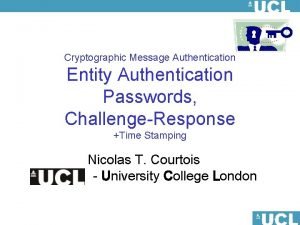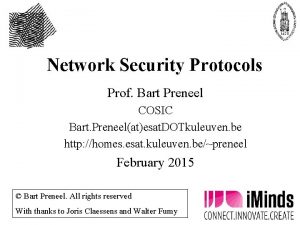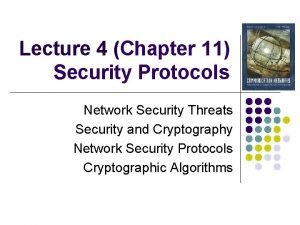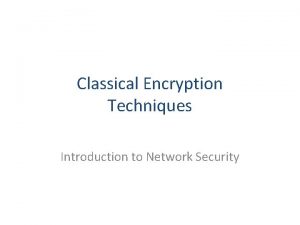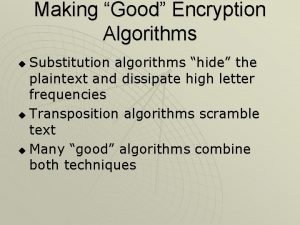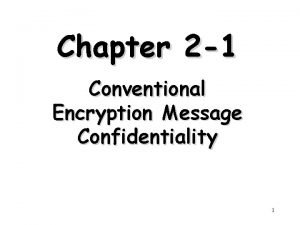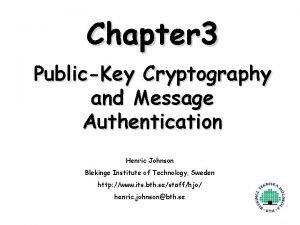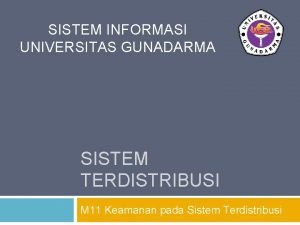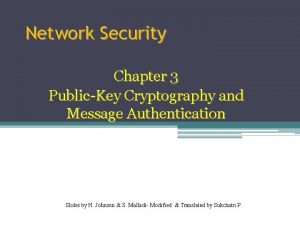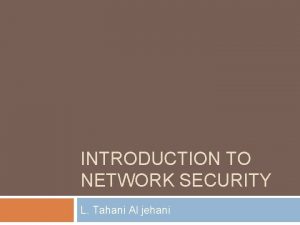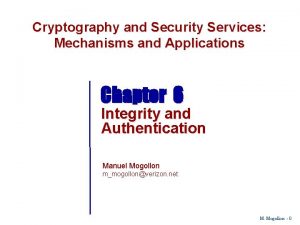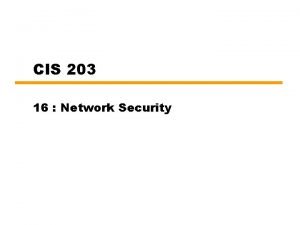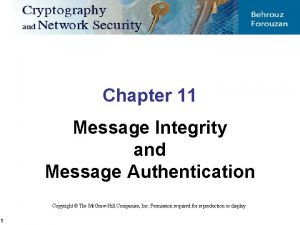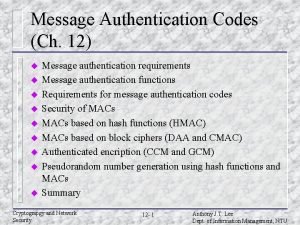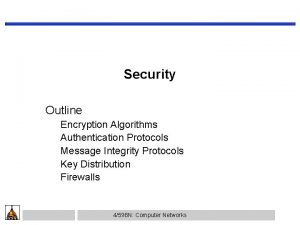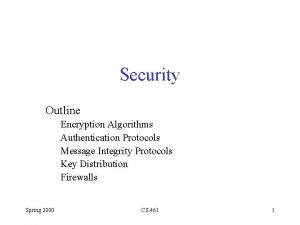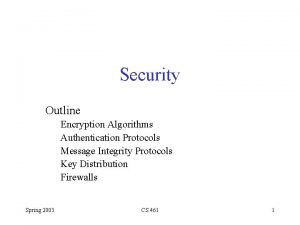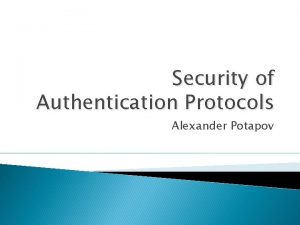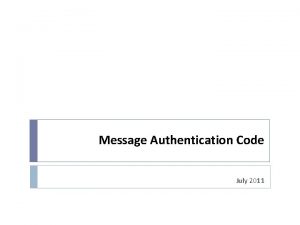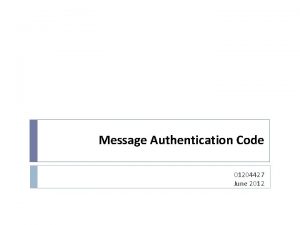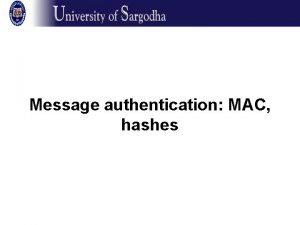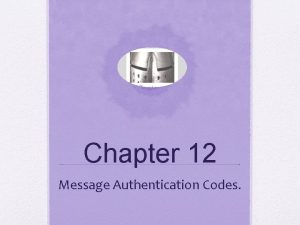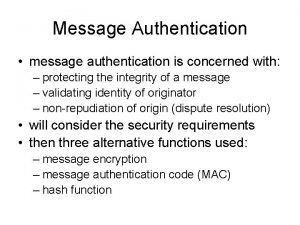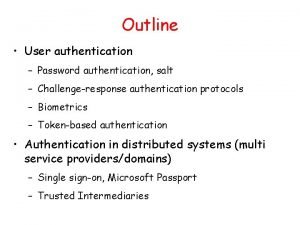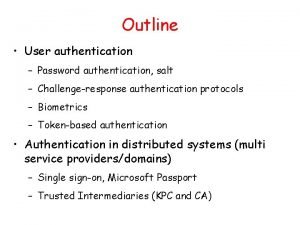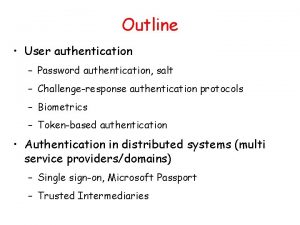Network Security Outline Encryption Algorithms Authentication Protocols Message



















- Slides: 19

Network Security Outline Encryption Algorithms Authentication Protocols Message Integrity Protocols Key Distribution Firewalls 1

Overview • Cryptography functions – Secret key (e. g. , DES) – Public key (e. g. , RSA) – Hash or Message digest (e. g. , MD 5) • Security services – Privacy: preventing unauthorized release of information – Authentication: verifying identity of the remote participant – Integrity: making sure message has not been altered 2

Secret Key (DES) 3

• Encrypts a 64 -bit block of plaintext with 64 -bit key (56 -bits + 8 -bit parity) • 16 rounds • Each Round 32 bits Li ─1 32 bits Ri ─1 F Ki + Li Ri 4

• Repeat for larger messages (Cipher Block Chaining, CBC) 5

Public Key (RSA) • Encryption & Decryption c = memod n m = cdmod n 6

RSA (cont) • Choose two large prime numbers p and q (each 256 bits) • Multiply p and q together to get n • Choose the encryption key e, such that e and (p - 1) x (q - 1) are relatively prime. • Two numbers are relatively prime if they have no common factor greater than one • Compute decryption key d such that d = e-1 mod ((p - 1) x (q - 1)) • Construct public key as (e, n) • Construct private key as (d, n) • Discard (do not disclose) original primes p and q 7

RSA Example • • • Example, p = 7, q = 11 n = p x q = 77 and (p-1)x(q-1) = 60 Pick a value of e that is relatively prime of 60, e = 7 d = 7 -1 mod ((7 -1) x (11 -1)) 7 d = 1 mod 60, we have d = 43 Public key <e, n> = <7, 77> Private key <d, n> = <43, 77> A message = 9 c = me mod n = 97 mod 77 = 37 m = cd mod n = 3743 mod 77 = 9 8

Message Digest • Cryptographic checksum – just as a regular checksum protects the receiver from accidental changes to the message, a cryptographic checksum protects the receiver from malicious changes to the message. • One-way function – given a cryptographic checksum for a message, it is virtually impossible to figure out what message produced that checksum; it is not computationally feasible to find two messages that hash to the same cryptographic checksum. • Relevance – if you are given a checksum for a message and you are able to compute exactly the same checksum for that message, then it is highly likely this message produced the checksum you were given. 9

Authentication Protocols • Three-way handshake Client Server Clien t. Id, E ( , C HK) Y E(y + , CHK ) ) SHK , K S E( x, y : random numbers, CHK, client handshake Key 10

• Trusted third party (Kerberos) T: Timestamp (like random number), L: Livetime, K: share session Key, 11

• Public key authentication A B E(x , Pu blic B ) x 12

Message Integrity Protocols • Digital signature using RSA – special case of a message integrity where the code can only have been generated by one participant – compute signature with private key and verify with public key • Keyed MD 5 – sender: m + MD 5(m + k) + E(k, private) – receiver • recovers random key using the sender’s public key • applies MD 5 to the concatenation of this random key message • MD 5 with RSA signature – sender: m + E(MD 5(m), private) – receiver • decrypts signature with sender’s public key • compares result with MD 5 checksum sent with message 13

Message Integrity Protocols • Digital signature using RSA – special case of a message integrity where the code can only have been generated by one participant – compute signature with private key and verify with public key • Keyed MD 5 – sender: m + MD 5(m + k) + E(E(k, rcv-pub), private) – receiver • recovers random key using the sender’s public key • applies MD 5 to the concatenation of this random key message • MD 5 with RSA signature – sender: m + E(MD 5(m), private) – receiver • decrypts signature with sender’s public key • compares result with MD 5 checksum sent with message 14

Key Distribution • Certificate – special type of digitally signed document: “I certify that the public key in this document belongs to the entity named in this document, signed X. ” – – the name of the entity being certified the public key of the entity the name of the certified authority a digital signature • Certified Authority (CA) – administrative entity that issues certificates – useful only to someone that already holds the CA’s public key. 15

Key Distribution (cont) • Chain of Trust – if X certifies that a certain public key belongs to Y, and Y certifies that another public key belongs to Z, then there exists a chain of certificates from X to Z – someone that wants to verify Z’s public key has to know X’s public key and follow the chain • Certificate Revocation List 16

Firewalls • Filter-Based Solution – example ( 192. 13. 14, 1234, 128. 7. 6. 5, 80 ) (*, *, 128. 7. 6. 5, 80 ) – default: forward or not forward? – how dynamic? 17

Proxy-Based Firewalls • Problem: complex policy • Example: web server • Solution: proxy • Design: transparent vs. classical • Limitations: attacks from within 18

Denial of Service • Attacks on end hosts – SYN attack • Attacks on routers – Christmas tree packets – pollute route cache • Authentication attacks • Distributed Do. S attacks 19
 Requirements of message authentication code
Requirements of message authentication code Message authentication and entity authentication
Message authentication and entity authentication Network security protocols
Network security protocols Network security protocols
Network security protocols Classical encryption techniques in network security
Classical encryption techniques in network security Authentication in cryptography and network security
Authentication in cryptography and network security Peer entity authentication definition
Peer entity authentication definition Making good encryption algorithms
Making good encryption algorithms Conventional encryption and message confidentiality
Conventional encryption and message confidentiality Approaches to message authentication
Approaches to message authentication Message authentication code
Message authentication code A digital signature needs a private key system
A digital signature needs a private key system Approaches to message authentication
Approaches to message authentication Message authentication is a service beyond
Message authentication is a service beyond Symmetric key
Symmetric key Black box crypto
Black box crypto Message authentication code
Message authentication code Message authentication code
Message authentication code Message authentication code
Message authentication code Message authentication functions
Message authentication functions

